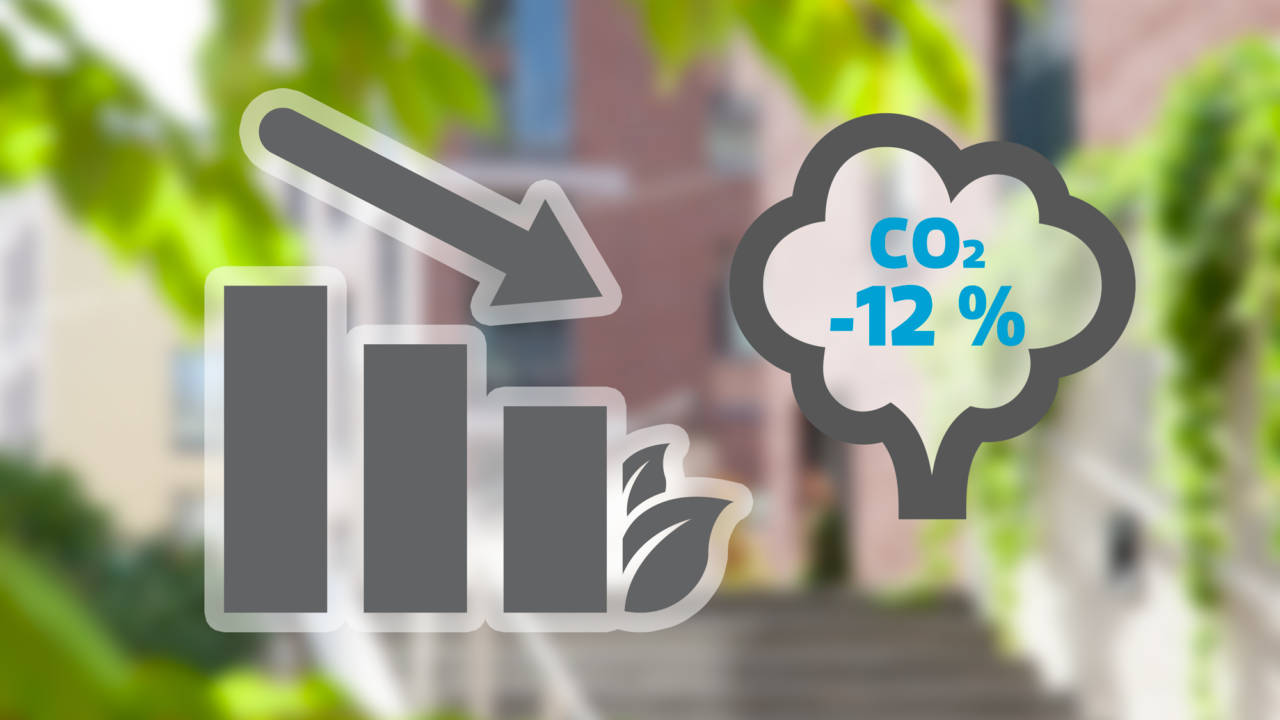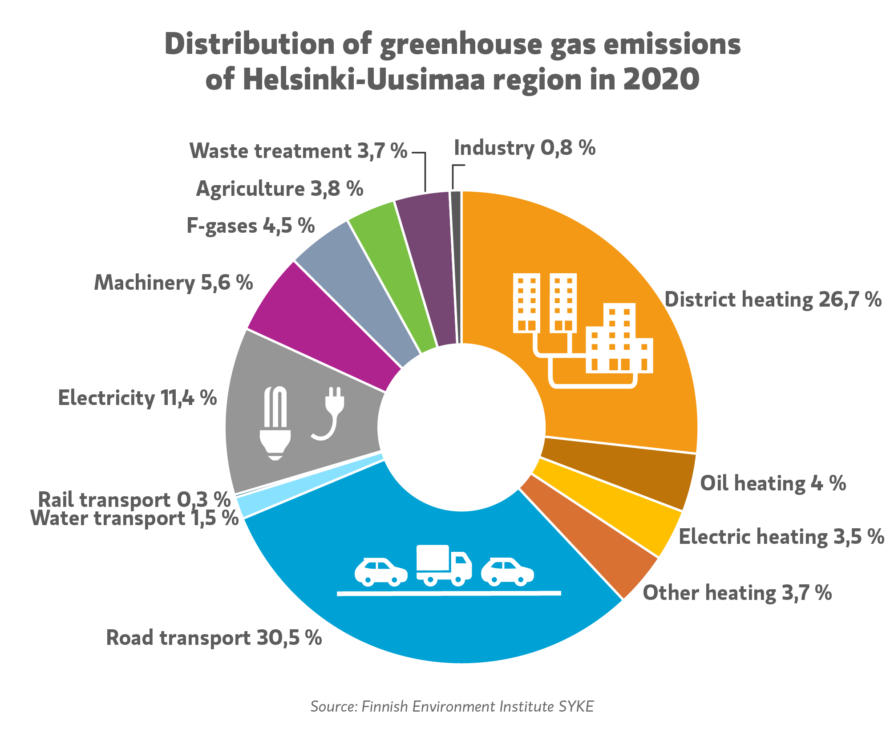Significant drop of 12 % in Helsinki-Uusimaa climate emissions 2020

Compared to 2019, preliminary data by the Finnish Environment Institute SYKE show a climate emission reduction of 12,1 % in the municipalities belonging to the Helsinki-Uusimaa Region. This regional drop is one third of the national result. The total decrease in all Finnish municipalities is 7,4 %.
– The latest emission data confirm a positive development of the emissions, which was already to be seen as a decrease of 7 % in 2019. This shows that the climate actions are giving good results. Ms Pia Tynys, the Chief Adviser of Climate Change at the Helsinki-Uusimaa Regional Council states that about a fifth of Finland’s emissions comes from the region she represents, so the work seems effective on a national level, as well.
In climate change mitigation, the measures in the energy sector are now standing out. Nationally, electricity shows the largest drop. In the calculation of emissions in 2020, an increased production of wind power is visible. A lower energy emission coefficient on a national level is having favourable effects on the development in our own region. District heating emissions are also clearly falling; by about 20 % in Helsinki-Uusimaa in 2020.
The results of the actions taken for a decrease in emissions are shown in calculations made by the municipalities. The emissions per resident of the cities Järvenpää and Kauniainen in 2020 were reduced to below 3 tCo2. In the time period of 2005–2020 that is a decrease by half.
– We have been taking on long-term activities for reducing district heating emissions in the capital region. During 2020, we can observe a clear decrease in this form of heating in every city. This goes for good regional development, as stated by the Climate Adviser of the Helsinki-Uusimaa Regional Council, Mr Simo Haanpää.
Last year, the cities of Espoo, Helsinki and Vantaa had emissions lower than 3,5 tCO2 per resident. In the entire Helsinki-Uusimaa Region, the emissions per residents were 4,5 tCO2 in 2019, and 3,9 tCO2 in 2020.

Decreasing emissions last year – also on a long term
– It is expected that some of the emission reductions occurred as a result of the exceptional COVID-19 year. In road transport, for example, emissions decreased mainly due to reduced distances driven, but the effects of improved energy efficiency and electrification of the vehicle fleet are also gradually beginning to show. The effects of the COVID-19 year on emission trends cannot be presented directly, but it is possible to derive the effects of the exceptional circumstances on the development of emissions from electricity use, water transport and industry”, says Mr Santtu Karhinen, Senior Research Scientist in charge of the calculation at SYKE.
SYKE’s calculations show a decrease of 7 % in the road transport emissions in Helsinki-Uusimaa 2019-2020. As an example, the passenger transport fell by approximately 10 % last year according to HSL, the Helsinki Regional Transport Authority. The COVID pandemic had a much bigger impact on public transportation, leading to a third less passengers.
In a long-term perspective, a positive development in emissions is visible. Emissions have decreased in almost every Finnish municipality during 2005—2020, showing an average change of 24 %. This change is about 27 % in Helsinki-Uusimaa.

Preliminary data improving the timeliness of emission calculations – Updates on new data
ALas, the emissions calculation system of SYKE covers all Finnish municipalities and 80 emission sectors. The emissions and energy consumption are calculated annually for all municipalities and sectors. The calculation model is updated when necessary; for example, based on new available data. Currently, final emissions calculation results are available for the years 2005–2019. The accurate results for 2020 are available by the spring of 2022.
The newly published regional preliminary data calculation of greenhouse gas emissions ALasPre was carried out for the first time in the ALas system. The purpose of the publication is to improve the timeliness of the calculation system by providing advance information on the emission trend before the publication of final statistics next spring. The preliminary data on emissions will be released already in spring 2022.
A fully consumption-based emissions accounting method is being developed alongside usage-based accounting, and it will be ready by early 2022. This makes it possible to get accurate information about every municipality’s household consumption of power, goods and services, as well as investments and public administration consumption.
A fully consumption-based emissions counting method offers another angle for local allocation and it supports the climate work in municipalities, alongside the current method of accounting.
The municipal emissions calculations system has received funding from the Life Ip Canemure project of the European Union: Canemure.
For more information, please contact:
- Ms Pia Tynys, Helsinki-Uusimaa Regional Council, phone +358 40 149 2244, pia.tynys@uudenmaanliitto.fi
- Mr Simo Haanpää, Helsinki-Uusimaa Regional Council, phone +358 50 525 5706, simo.haanpaa@uudenmaanliitto.fi
- Mr Santtu Karhinen, Finnish Environment Institute, phone +358 295 251 889, santtu.karhinen@syke.fi
Take also a look at these
 News
News
1.7.2025
Helsinki Regional Council committing to green deal agreement: reducing the use of natural resources to the level of 2015
Circular economy is no longer a mere environmental accomplishment - it is also about competitiveness, security of supply and generally, savings. To promote a sustainable resource-wise future, the Helsinki-Uusimaa Regional Council has joined a regional green deal for circular economy. The green deal is a voluntary commitment in which the participating municipalities are offered support for concrete actions and gives them new opportunities to find solutions and start pilot projects.
 News
News
26.6.2025
Stories from the Circular Hub – Helsinki-Uusimaa on the road to circular economy
More and more sectors are now furthering a transition to circular economy. The Helsinki-Uusimaa Circular Hub was an import cooperation platform for circular economy solutions in the Helsinki-Uusimaa Region, founded in 2023. Highlights from the first project years of the Circular Hub have now been put together in the publication Stories from the Circular Hub, raising both the updates of the sectors and the actors of the regional Hub.